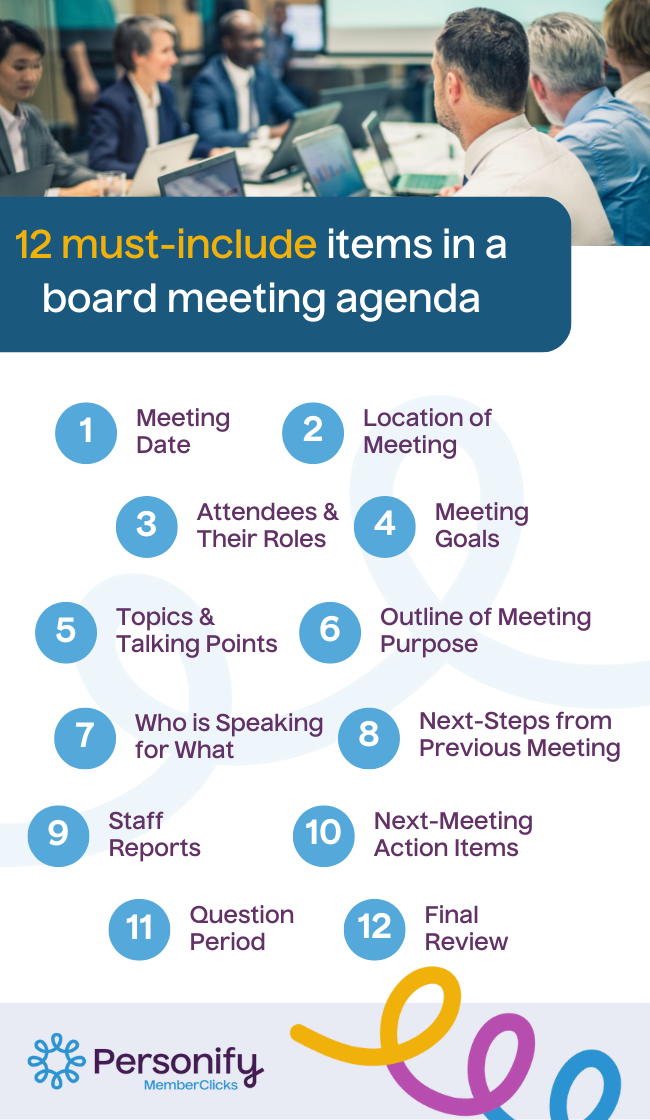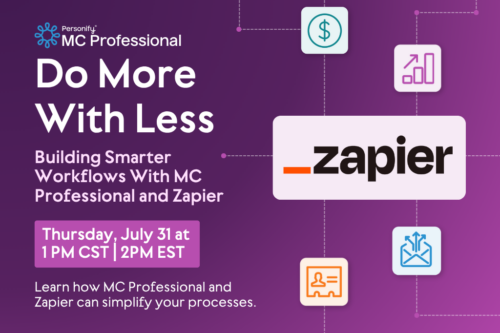Nearly everyone who works in a non-profit or association has sat through a board meeting that went off-topic or ran over time. It usually isn’t a big deal if the board and staff present have the extra time. In fact, sometimes the off-topic conversations or additional time end up being the most productive part of the meeting.
But board meetings that routinely go over time or off-topic could end up causing organizational problems. Board members might decide to step down if their time is consistently not respected. Or unplanned topics could use up time set aside for time-sensitive conversations.
Good board meeting agendas solve this problem. In fact, good board meeting agendas are key parts of good board and organizational governance.
Wondering what an effective board meeting agenda looks like? We’ll give you an overview, detailed instructions on how to create an effective agenda, and a board meeting agenda template to use to make your own.
What is a meeting agenda?
A board meeting agenda is a document that lays out everything that will take place during a board meeting. That includes where and when the meeting will take place, who will be present, what their roles are at the meeting and what items are on the agenda for discussion.
Agenda items can include things like approving old meeting minutes, listening to staff or committee reports, approving financial expenditures, discussing strategic directions and whatever else needs to be discussed.
Agenda items are listed in chronological order and allotted a period of time in the agenda for the discussion to take place.
Why is it good to have an agenda for a board meeting?
Board meeting agendas set the direction and tone of the meeting. They are crucial to:
- Ensure everything that needs to be dealt with at a board meeting is addressed
- Inform attendees what needs to be done about each agenda item
- Set the stage for collaborative conversations
- Help attendees understand other attendees’ roles
- Set time limits for the discussion of items to ensure meetings don’t go over time
- Reduce the number of off-topic conversations that take place
- Help organizations get the most value from their board directors
- Make it easier for staff or board secretaries to follow along and take minutes
- Help the board chair lead the meeting
- Create a record of what was discussed at a meeting
- Help retain great board directors (it takes a lot of work to recruit an effective and diverse board, you don’t want to lose anyone over badly run meetings!)
How to structure a board meeting agenda
Board meeting agendas follow a pretty standard form but organizations often use that form differently. The first step to creating a great board meeting agenda is to understand your board.
For example, if your board likes to start with a financial update, be sure to put that as the first item of new business on the agenda. If they typically ask a lot of questions about a particular program, adjust the agenda to allow for more discussion on that topic next time and reduce the time allotted for another topic. Or if they stick around to ask staff follow up questions after the meeting is officially finished, consider leaving time for questions at the end of each meeting in the future.
If there have recently been new additions to the board, you might need to adjust how you plan your agenda. For example, if the new board member likes to ask probing questions about one part of the agenda give that part of the program more time. Be sure to also make enough time for things that require more discussion. For example, if you are talking about starting a new program or pitching a new Association Management Software, you’ll want to set aside extra time.
An agenda shouldn’t be a template you make once and stick to indefinitely. It should be a living document you adapt in order to create the most effective meetings for everyone.
Tips to get the most out of your agenda
So, how do you get the most out of your agenda? Here are some suggestions:
- Brand it with your logo and use your organization’s brand colors and fonts.
- Stay consistent with one agenda template, even if you vary the order in which you plan the meetings. It will make it easier for board members to find the information they need.
- Ask for additions to the agenda more than once. Ask at the end of the previous board meeting and then send out a request for agenda suggestions a week before the board meeting. That will cut down on unexpected additions at the start of board meetings.
- Share the agenda three days to a week ahead of time.
- Schedule a bit of extra time for each item in the agenda just in case items run over time.
- Don’t be afraid to apply time limits and tell board members when they are going over the time allotted.
- Don’t have one person do all the work of ensuring the meeting stays on track. Have one person lead the meeting, another take meeting minutes, and a third monitor the time.
Typical process of a board meeting
Unsure how a board meeting typically proceeds? Generally, the board chair calls the meeting to order and asks if there are any changes or additions to the agenda. After that, the board chair or another member moves to approve the agenda.
At that point, the previous meeting’s minutes might be reviewed and approved or amended. From there, boards might review old business from the previous meeting, look at reports from staff, provide updates from committees, make announcements, or discuss other business items.
Boards sometimes have a set order they like to discuss regular, new, and old business. If in doubt, look at an old agenda or ask for an agenda sample from a previous board meeting.

12 things you must include
So, what’s absolutely necessary to include in a board meeting agenda? Here are some board agenda basics:
- The date
- The meeting location
- The attendees and their titles (ex. Board member, board position, staff, or guest)
- Goals of the meeting
- Calls for new business, agenda topics, and the approval of the previous meeting’s minutes
- A high-level outline of what will be discussed
- Information about who will be leading the discussion of each item on the agenda
- An update on action steps agreed to at the previous meeting
- Committee or staff reports
- Time to discuss action items for the next meeting
- A question period (optional)
- A final review (optional)
Printed VS digital agenda
We’re all trying to reduce paper usage these days so you might be wondering if it make sense to print your meeting agenda.
The best strategy is to give board members both a digital and a printed copy. Send out a digital board agenda three to seven days before the board meeting. Then print copies of the board agenda for anyone who wants one during the meeting.
Board member can then choose which way they prefer to look at the agenda. You’ll also know that those who forgot to print their agendas themselves or don’t bring their computer with them to meetings will have a copy of the agenda in front of them. Printed agendas can help keep a board meeting on track.
Template for a board agenda
There are a lot of great resource to help you build an agenda, including free Word templates and free agenda samples for board meetings. But some of those agenda templates miss key sections or details you should include. That’s why we created a board meeting agenda template to make it easier to create a great agenda.
Board meeting agendas are a great tool
Creating and following great board agendas can pay significant dividends for boards and organizations. By ensuring that your board knows and has time to properly address all the topics they need to weigh in on, you improve board and organizational governance.
Well crafted agendas translate into well-run board meetings. And that leads to happier board members and stronger organizations.
















